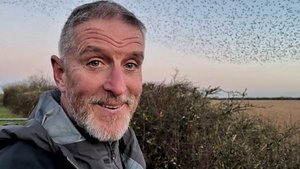Winterwatch in Wales
Episodes

1. Taking Refuge
2025-02-18
Iolo Williams explores how animals seek refuge in winter by looking back at stories from Winterwatch and Autumnwatch. He begins in an old mine near Machynlleth, where he discovers insects sheltering from the weather. However, there is danger lurking in the shadows in the form of cave spiders, which will feast on small creatures that venture too close.

2. Adaptation
2025-02-18
Iolo Williams explores the various strategies that animals use to survive harsh winters, including the incredible adaptations that mean ducks' feet don’t freeze and pond creatures can survive under ice. Iolo also visits a greater horseshoe bat roost before they move on to hibernate and searches for the caterpillars of marsh fritillary butterflies that overwinter in special frost-resistant webs.

3. Intelligence
2025-02-18
Iolo Williams showcases animals that use intelligence to survive the challenges of winter. He begins on Anglesey, where he joins raven expert Nigel Brown to investigate these highly intelligent birds, using thermal imagery to uncover the secrets of their night-time activities. Ravens are highly social and raucous as they gather to roost and share information about where food can be found – vital when resources are scarce. While ravens are masterminds of the air, beneath the waves, a curled octopus is on the hunt - but will this cunning creature be outwitted by a crafty cuttlefish?

4. Finding Food
2025-02-18
In winter, finding a meal can be a life-threatening challenge for many creatures. Iolo Williams investigates how wildlife avoids starvation when sustenance is scarce by looking back at some of the best seasonal stories from Autumnwatch and Winterwatch. In north Wales, many wading birds are drawn to the abundance of food on the shorelines of the Menai Straits. Among them, the aptly named turnstone finds food that others can’t reach by lifting heavy rocks with its strong neck and beak, rummaging through the pebbles in search of tasty invertebrates. Many of us put out food for wildlife in our gardens, but photographer Richard Bowler managed to attract a real rarity - a highly elusive polecat. Using cameras that trigger automatically, and some irresistible snacks, he captured some amazing images of one individual that is a real character.

5. Next Generation
2025-02-18
While many species are simply trying to stay alive at this challenging time of year, others are focusing on the next generation. Iolo Williams looks back at some of the best seasonal stories of reproduction featured on the watches over the years. He begins with an autumn visit to Skomer Island, where a globally important colony of Manx shearwaters breed in burrows underground. The parent birds have already left on their mammoth migration to South America, but their chicks are left to fend for themselves until they are ready to fledge. Under the cover of darkness, dozens of chicks clamber up Iolo and scientist Tim Guilford to gain as much height as possible for their maiden flight. It’s a once-in-a-lifetime experience for Iolo as chicks launch themselves from his head before setting off on a daunting journey to cross the Atlantic. With no parents to guide them, these remarkable birds rely on instinct to navigate thousands of miles across the ocean.

6. Hidden Treasures
2025-02-18
Iolo Williams tracks down some of Wales’s most elusive creatures and sheds light on how some of them remain undetected. He begins by revealing the array of tiny creatures that take refuge in a log pile in winter: a hibernating butterfly, a centipede on the hunt and a dedicated earwig mother carefully tending to her eggs. Beneath the waves, marine animals are also hidden from view, but many also try their best to hide from each other. Sand gobies are well camouflaged against the seafloor but must be vigilant, as an angel shark, a rare creature filmed for the first time in UK waters, buries itself in the sand to ambush its prey from below.